SUBFAMILY MYRMICINAE - Genus Pyramica - subgenus Epitritus
| The Ants of
Africa SUBFAMILY MYRMICINAE - Genus Pyramica - subgenus Epitritus |
|
| Genus Pyramica |
In Tribe DACETINI.
Diagnostic Features - Head elongated with numerous large orbicular hairs. Antennae 4- or 6-segmented, the scape lobiform basally. Mandibles elongate with no more than a single preapical tooth; apical armament of a long dorsal spiniform tooth subtended by a vertical series of denticulae or the denticulae alone. Labrum projecting anteriorly between the mandibles as a biconical structure; clypeus with spatulate or strap-like projecting hairs.
Haliday's (1869a) genus description is at ![]() . Arnold (1917: 384) gave a translation of
the expanded description given by André (1883b: 402), based upon the
European species Epitritus argiolus (the genotype); this is at
. Arnold (1917: 384) gave a translation of
the expanded description given by André (1883b: 402), based upon the
European species Epitritus argiolus (the genotype); this is at ![]() .
.
Bolton (1971b, 1973a) mentions that three species of these minute (TL 1.2-2.2) ants had been found in West Africa. One species from the northern savannah of Nigeria (Brown, 1962), and two from the forest zone of eastern Ghana, found from Berlese funnel samples of leaf litter. A further species was described in the later revision by Bolton (1983).
This appears to be the same as what Bolton (2000: 269) separated as
the "argiola-group". The
members were as earlier plus argiola
and three new species, marchosias,
anorbicula and mormo.
Key to African species (adapted from Bolton, 1983):
| 1 | 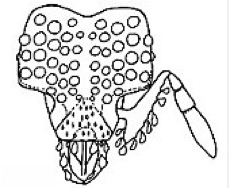 Antennae with 4
segments; TL 1.2 mm, HL 0.29, HW 0.39, SL 0.17 Antennae with 4
segments; TL 1.2 mm, HL 0.29, HW 0.39, SL 0.17 |
. |
| . |  |
West Africa - minima |
| -- | Antennae with 6 segments | 2 |
| 2 | 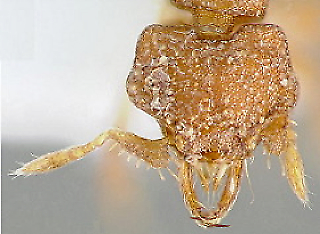 Dorsum of head
without numerous large orbicular hairs; anterior margin of clypeus with
projecting long, filiform hairs; TL 2.0-2.2 mm, HL 0.48-0.50, HW
0.60-0.66, SL 0.25-0.28 PW 0.34-0.40 Dorsum of head
without numerous large orbicular hairs; anterior margin of clypeus with
projecting long, filiform hairs; TL 2.0-2.2 mm, HL 0.48-0.50, HW
0.60-0.66, SL 0.25-0.28 PW 0.34-0.40 |
Gabon - anorbicula |
| -- | Dorsum of head with numerous large orbicular hairs; anterior margin of clypeus with projecting broad, strap-like hairs | 3 |
| 3 |
Tooth at dorsal apex of mandible long and spine-like; crossing over opposite mandible when blades closed | 4 |
| -- | Tooth at dorsal apex of mandible short, not spine-like | 5 |
| 4 | 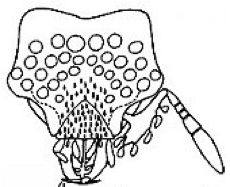 Mandible
with a single small preapical tooth close to the apicodorsal tooth;
head behind clypeus with appressed small spatulate hairs; large hairs
on scape curved forwards; TL 1.9 mm, HL 0.45, HW 0.58, SL 0.26 Mandible
with a single small preapical tooth close to the apicodorsal tooth;
head behind clypeus with appressed small spatulate hairs; large hairs
on scape curved forwards; TL 1.9 mm, HL 0.45, HW 0.58, SL 0.26
|
. |
| . | 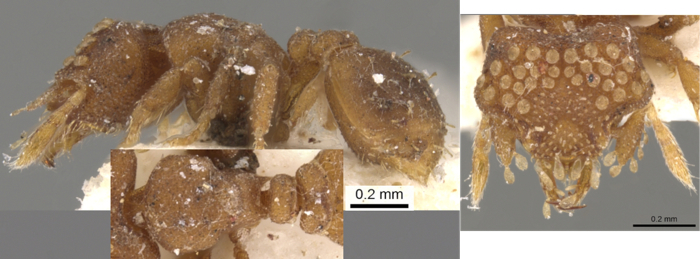 |
West Africa & Congo Basin - roomi |
| -- | Mandible with a two preapical teeth
on distal half of the blade; head behind clypeus with orbicular hairs;
large
hairs on scape directed at right angles; TL 2.2 mm, HL 0.52, HW 0.64,
Sl 0.31 (no illustrations available) |
Zaire - mormo |
| 5 | 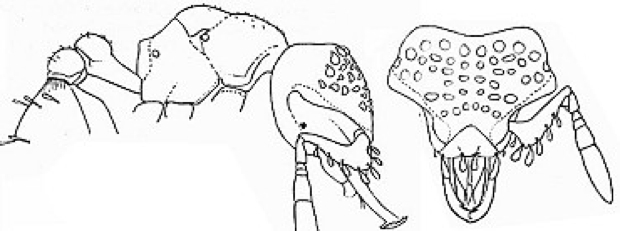 Dorsal surface of
each mandibular blade without large flattened hairs on the distal half;
posterior half of mesonotum convex; TL 1.7-2.2 mm, HL 0.40-0.48, HW 0.46-0.59, SL 0.33-0.29, PW 0.26-0.32 Dorsal surface of
each mandibular blade without large flattened hairs on the distal half;
posterior half of mesonotum convex; TL 1.7-2.2 mm, HL 0.40-0.48, HW 0.46-0.59, SL 0.33-0.29, PW 0.26-0.32 |
. |
| . | 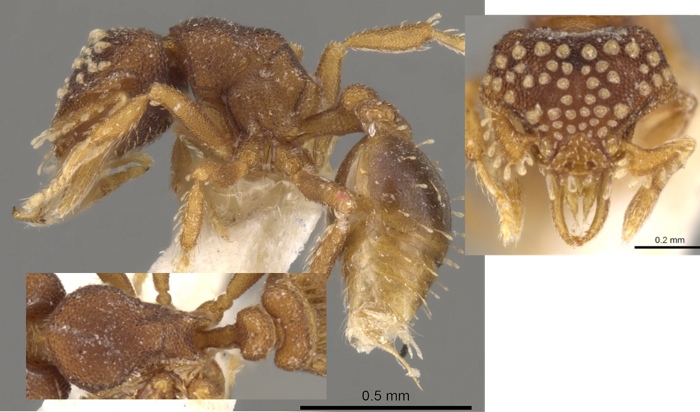
|
West Africa - laticeps |
| -- | Dorsal surface of each mandibular blade with 2 large flattened hairs on the distal halfout flattened hairs; | 6 |
| 6 | 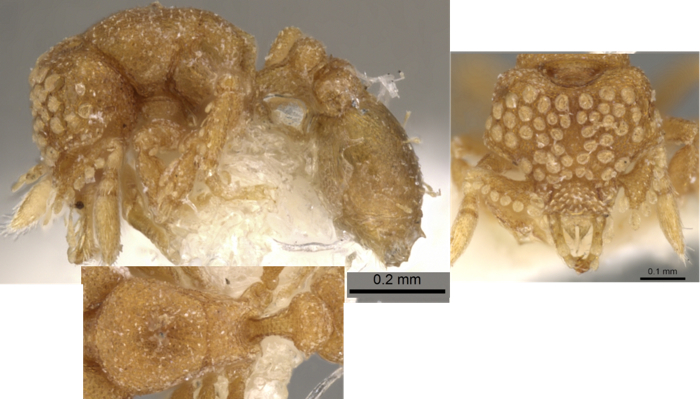 Posterior half of
mesonotum humped in profile; mandibles with truncated teeth on apex; TL 1.4 mm, HL 0.34, HW 0.39, SL 0.20, PW 0.25 Posterior half of
mesonotum humped in profile; mandibles with truncated teeth on apex; TL 1.4 mm, HL 0.34, HW 0.39, SL 0.20, PW 0.25 |
West Africa - tiglath |
| -- | 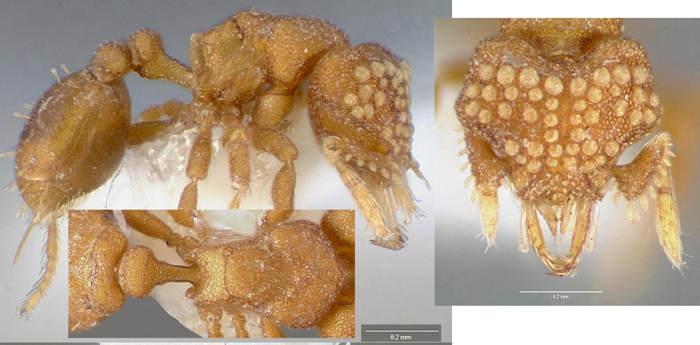 Mandibles with
elongated apical teeth; TL 1.5-1.7 mm, HL 0.37-0.43, HW 0.45-0.51, SL -.19-0.22, PW 0.27-0.32 Mandibles with
elongated apical teeth; TL 1.5-1.7 mm, HL 0.37-0.43, HW 0.45-0.51, SL -.19-0.22, PW 0.27-0.32 |
Gabon - marchosias |
| MYRMICINAE Introduction |
© 2007, 2013, 2015 - Brian Taylor CBiol FSB FRES 11, Grazingfield, Wilford, Nottingham, NG11 7FN, U.K. |
href="epitritus.htm"